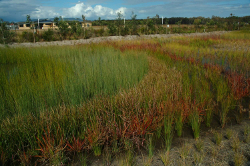Potential benefits from this intervention:
- Water quality improvement at a range of scales from house block or paddock scale, through to regional scale systems treating runoff from multiple properties or a whole catchment, if used in conjunction with best practice land management.
- Treatment systems can be effective at reducing contaminant loads from diffuse sources and point sources.
- Some treatment systems will be relatively cheap and effective, located close to the land use and have minimal operating requirements, with few ongoing costs.
- There are several types of treatment system options that can be designed for specific pollutants and land uses. This may include enhancing the natural hydrologic, physical, biological or chemical processes and components (parts of the system e.g. soil, vegetation etc.) to remove specific pollutants from water.
Potential negative implications from this intervention:
- Treatment systems can be overloaded by pollutants if not sited and designed correctly and can become damaged and costly to fix.
- They may have high maintenance requirements, which can include having to remove toxic sediment and dispose of it appropriately.
- Requires a high degree of acceptance by the community/landholder, and a requirement to maintain and use the treatment system as designed.
Intervention considerations:
- Seek appropriate specialist advice and check legal obligations (e.g. permits).
- The treatment system must be designed for the quantity and quality of water entering the system to be effective and not overload the system.
- Location in the landscape and catchment characteristics (such as hydrological regime, wet and dry seasons, runoff and waterway connectivity).
- Scale at which the pollutants are being treated - from paddock to regional scale.
- Land uses, and pollutant types that are being treated, which will decide the type of treatment system required.
- The values in the receiving environment.
- Should be part of a treatment train for water quality improvement together with best management practices, and possibly other existing treatment systems.
- Cost effectiveness, and ongoing maintenance of the system.
- Safety of volunteers and employees including seasonal exposures (e.g. heat) and high risk areas (e.g. crocodile presence in waterways).
Links:
Treatment Systems
Treatment systems for agriculture
Urban stormwater treatment
Treatment Systems for intensive land uses
Wetland treatment systems for nitrogen removal: a synthesis
Last updated: 1 June 2022
This page should be cited as:
Department of Environment, Science and Innovation, Queensland (2022) Treatment systems, WetlandInfo website, accessed 18 March 2024. Available at: https://wetlandinfo.des.qld.gov.au/wetlands/management/rehabilitation/rehab-process/step-4/intervention-options/treatment-systems.html

 — Department of Environment, Science and Innovation
— Department of Environment, Science and Innovation


